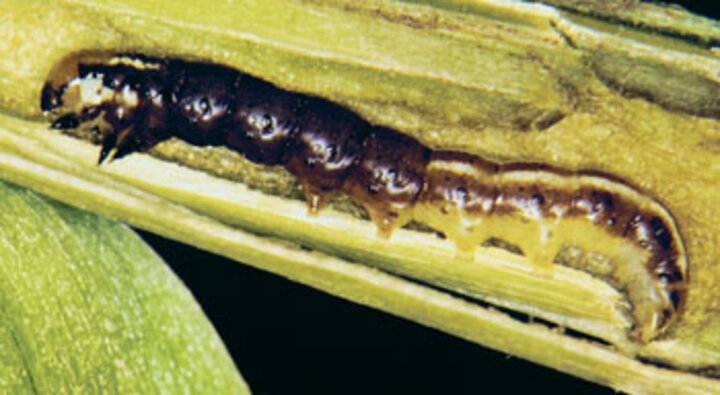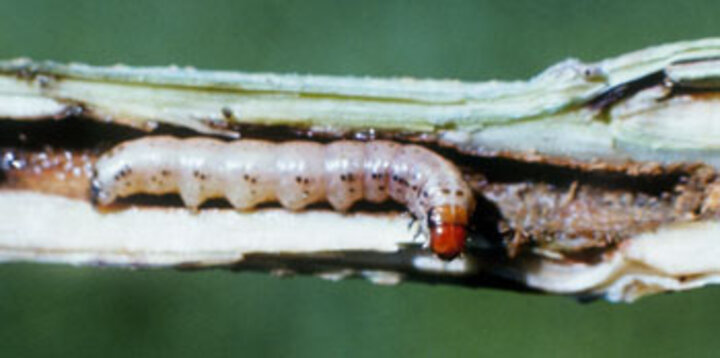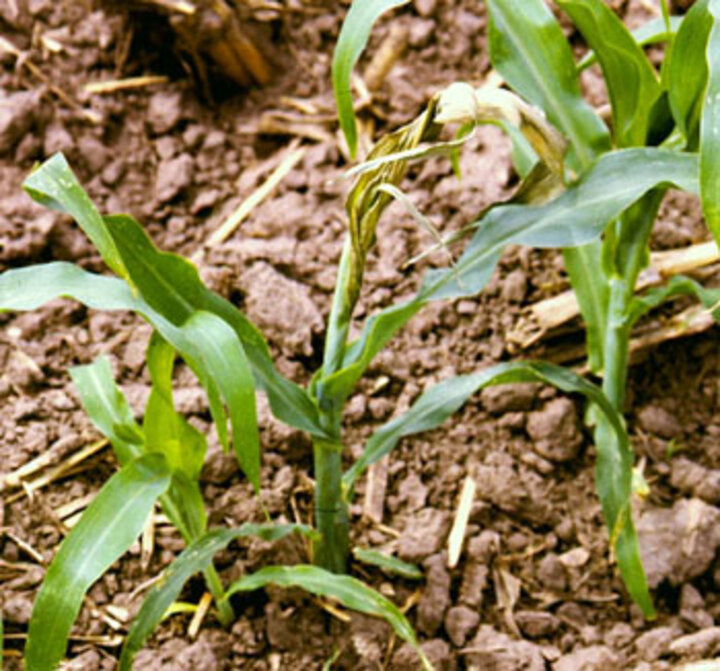
Forecasting Stalk Borer Growth Stage
Stalk borer hatch and migration to new hosts can be predicted using degree days (DD). Based on research at Iowa State University, stalk borer egg hatch begins at about 575 DD and ends at 750 DD. Begin scouting corn when 1,300-1400 DD have accumulated. This corresponds with the beginning of larvae moving out of grassy hosts. Determine the need for treatment when 1,400-1,700 DD have accumulated.
This week's map indicates that corn growers in southeast Nebraska and in counties bordering Kansas should be scouting now.
| Table 1. Degree day requirements for common stalk borer development and management activities (41°F base). |
|
| Degree day accumulation from Jan. 1 |
Event (Egg and larva development) |
| 575 | Egg hatch begins |
| 750 | Egg hatch complete |
| 1,400 | 10% of larvae move out of grasses |
| 1,700 | 50% of larvae move out of grasses |
| Event (Pest control) | |
| 1,300-1,400 | Begin scouting grassy field borders and corn |
| 1,400-1,700 | Make insecticide treatment decision in corn |
Corn growers in southeast Nebraska and in counties bordering Kansas should be scouting their fields for common stalk borers and making management decisions. Stalk borer growth is based on accumulated degree days, using a base of 41°F since January 1. With a warmer than normal spring, common stalk borers will develop earlier than normal and growers should be prepared to treat, based on growth stage and the thresholds noted below.
Stalk borers are an occasional pest of corn in Nebraska. Stalk borer damage in corn commonly is confined to plants in the first few rows near field margins, fence rows, grass terraces, and waterways. In addition to attacking corn, stalk borers attack over 100 other species of plants, including ornamentals, garden vegetables, broadleaf weeds, and grasses. They may feed on soybeans as well, but they are not an economically important pest of soybeans.
Understanding the common stalk borer life cycle and behavior is critical to selecting management practices to reduce damage in corn.
Stalk Borer Life Cycle
Female stalk borer moths lay their eggs primarily on grasses such as smooth brome or ragweed in late summer and early fall. Egg-laying sites usually are in fence rows, terraces, and waterways, but can be found throughout a field if preferred hosts are available. Eggs overwinter and hatch in late April or early May. Larvae bore into the stalks of grasses or other hosts such as ragweed, and begin feeding. As they become larger or if the plants are mowed or burned down with herbicides, the stalk borers migrate into adjacent corn plants to complete their development. In some cases, if an appropriate weed host is not available when eggs hatch, stalk borers may begin feeding directly on corn.
Corn between the two- and eight-leaf stages can be attacked by the migrating stalk borer larvae. Larvae develop through seven to 10 instars, or stages, in about 10 weeks. Pupation occurs in the soil and moths emerge in August, September, and early October. There is a single generation each year.
Stalk Borer Identification
Common stalk borer larvae are distinctive in appearance. Young larvae (Figure 2a) are brownish-purple and have three prominent longitudinal white stripes at the front and rear ends of the body. The stripes are interrupted at mid-body by a solid dark purple to black area on the third thoracic segment and first three abdominal segments. Fully grown larvae do not have these characteristic markings and are uniformly dirty gray (Figure 2b). Fully grown larvae can be 1 1/2 to 2 inches long.
Stalk Borer Damage
Stalk borer larvae injure corn plants in June and early July. They feed on leaves in the whorl and then tunnel into the stalk, or they burrow into the base of the plant and tunnel up through the center of the stalk. Leaf feeding alone does not cause economic damage.
Tunneling into the stalk can result in deformed or stunted plants that may not produce an ear. Severely damaged plants can die. Plants attacked at earlier growth stages tend to be more severely injured. A single stalk borer larva may attack more than one plant if the first plant does not support the larva as it increases in size.



Management
Any weed control method that helps eliminate grasses will reduce the number of potential stalk borer egg-laying sites, reducing the probability of stalk borer damage the next year. Control of grassy weeds is important to keep stalk borer problems from increasing year to year.
Planting date may have some influence on the degree of injury from common stalk borers. Since smaller plants are more heavily damaged, earlier planting may allow corn to outgrow the most severe damage.
If most common stalk borer damage is next to grassy field borders and waterways, burning these areas before eggs hatch has been shown to reduce populations. The best time is to burn these areas in late winter, before the grass begins to grow. At this time all eggs have been laid, and the soil will be bare and subject to erosion for the shortest time. Also, this timing has the least effect on bird populations that have not yet begun to nest.
Sampling and Economic Injury Levels
Check corn plants bordering grassy areas to determine the percentage of plants with stalk borer injury when 1,300-1,400 degree days (41°F base) have accumulated since January 1 (see Figure 1). Examine several sets of 10 plants. Look for feeding damage and dissect damaged plants to see if live larvae are present. If weedy grasses were common throughout the field in the previous year, the whole field may need to be scouted for common stalk borers. Use the information in Table 2 to determine the economic injury level.
Treatment
To be effective, insecticides must be applied before common stalk borer larvae have entered the stalk. In cases where stalk borers begin feeding on grassy weeds or other vegetation in field edges, control is most effective if timed between 1,400 and 1,700 degree days (base 41°F), which corresponds to first half of the period that stalk borers are migrating from weedy hosts into corn. If the infestation is restricted to the field margin, use a border treatment.
In cases where there is a history of fieldwide stalk borer damage at a site, insecticides applied to corn and timed for egg hatch may be used to reduce damage. The disadvantage of this approach is that there is no effective way to sample for stalk borers at this time, so treatments are made without knowledge of whether an insecticide treatment would be profitable that year.
Insecticides may be mixed with fast-acting herbicides being used to burn down early season weeds, or applied several days after use of slower-acting herbicides. Check the label for compatibility of different insecticide and herbicide mixtures.
A variety of foliar insecticides are effective against common stalk borers in corn. See related information in the Extension section on the UNL Department of Entomology website or the insecticide label information for labeled insecticides, their rates, and restrictions.
Of the currently available Bt corn hybrids, only those expressing the CrylAb Bt protein have any activity against common stalk borer. (See Handy Bt Trait Table for a list of available hybrids.) The labels for these hybrids indicate that they provide suppression of common stalk borer. The label term "suppression" indicates that a lower level of mortality is expected than for insects labeled for control.
Resources
For more information on stalk borer biology and management, see
- “Stalk Borer Ecology and Integrated Pest Management in Corn,” a 2010 article by Marlin Rice and Paula Davis in the Journal of Integrated Pest Management
- Common Stalk Borer in Corn, NebGuide G521.
Bob Wright
Extension Entomologist, Lincoln
| Table 2. Economic thresholds based on percent of infested plants for common stalk borer on corn for different corn leaf stages and expected yield (Iowa State University). | ||||||||||||||||
| $5/bu | $6/bu | $7/bu | ||||||||||||||
| Leaf stage |
150 | 175 | 200 | 225 | Leaf stage |
150 | 175 | 200 | 225 | Leaf stage |
150 | 175 | 200 | 225 | ||
| 1 | 3.46 | 2.97 | 2.60 | 2.31 | 1 | 2.89 | 2.47 | 2.16 | 1.92 | 1 | 2.47 | 2.12 | 1.86 | 1.65 | ||
| 2 | 4.23 | 3.63 | 3.17 | 2.82 | 2 | 3.53 | 3.02 | 2.65 | 2.35 | 2 | 3.02 | 2.59 | 2.27 | 2.02 | ||
| 3 | 5.60 | 4.80 | 4.20 | 3.73 | 3 | 4.67 | 4.00 | 3.50 | 3.11 | 3 | 4.00 | 3.43 | 3.00 | 2.67 | ||
| 4 | 5.95 | 5.10 | 4.46 | 3.97 | 4 | 4.96 | 4.25 | 3.72 | 3.31 | 4 | 4.25 | 3.64 | 3.19 | 2.83 | ||
| 5 | 6.80 | 5.83 | 5.10 | 4.54 | 5 | 5.67 | 4.86 | 4.25 | 3.78 | 5 | 4.86 | 4.16 | 3.64 | 3.24 | ||
| 6 | 11.90 | 10.20 | 8.93 | 7.94 | 6 | 9.92 | 8.50 | 7.44 | 6.61 | 6 | 8.50 | 7.29 | 6.38 | 5.67 | ||
| 7 | 32.84 | 28.15 | 24.63 | 21.89 | 7 | 27.37 | 23.46 | 20.53 | 18.24 | 7 | 23.46 | 20.11 | 17.59 | 15.64 | ||
